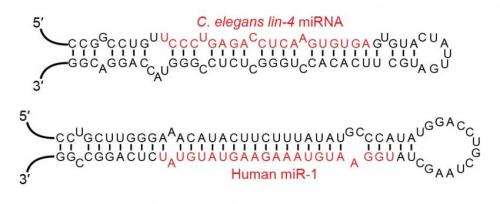A role for microRNAs in social behavior

The recent discovery of microRNAs as key regulators of biological processes has fueled an explosion of research activity into their function in health and disease. Researchers have now uncovered a microRNA cluster that regulates synaptic strength and is involved in the control of social behaviour in mammals. The researchers presume that their discovery may point to new therapeutic strategies for the treatment of social deficits in neurodevelopmental disorders such as autism spectrum disorder or schizophrenia. The research is published today in EMBO Reports.
Textbook knowledge holds that DNA is first copied to make messenger RNA molecules (mRNAs) that are then translated into protein. MicroRNAs are short snippets of RNA that do not code for a protein. Rather, they function mainly by regulating the stability or translation rate of mRNAs, thereby inhibiting the production of particular proteins. These microRNAs form a whole new layer of gene regulation that has only been uncovered in the past 15 years. Each microRNA typically targets hundreds of different mRNAs, making them ideal for coordinating complex cellular processes.
In their work at the University of Marburg, Germany and later on at ETH Zurich, Switzerland, the research group of Gerhard Schratt and other laboratories have uncovered that a cluster of 38 microRNAs, termed miR379-410, plays an important role in neural development. Moreover, several hints pointed to the possibility that miR379-410 is involved in social behaviour. Schratt and colleagues now investigated this option in more detail and found that miR379-410 indeed regulates sociability in the brain of mice. The study opens up a new perspective on the molecular mechanisms behind social behaviour.
The researchers first observed that mice lacking a functional miR379-410 complex were more sociable than their littermates, indicating that miR379-410 functions to restrict sociability in healthy animals. Further investigation showed that neurons in the hippocampus of the brain in mice lacking miR379-410 formed more connections and were more likely to transmit electrical signals. "Our study indicates that miR379-410 plays an important role in the development of neural circuitries that control social behaviour," explains Schratt.
At the molecular level, the miR379-410 complex targets thousands of genes, among them many that were known to function in regulating synaptic transmission. Moreover, a small subgroup of only five microRNAs from the cluster might explain to a large extent the upregulation of key synaptic proteins. These proteins are involved in a process termed homeostatic synaptic downscaling—a feedback loop that kicks in when the brain becomes overactive because synaptic contacts are too strong.
While the current study uses mice as a model organism, there are indications that the miR379-410 complex is also involved in the regulation of social behaviour in humans. For example, several miR-379-410 members are dysregulated in the blood and brain of patients with neurodevelopmental disorders that affect social behaviour, such as schizophrenia or autism spectrum disorder. "We hope that our study will contribute to the development of treatments to ameliorate social deficits in neuropsychiatric conditions in the future," says Schratt.
More information: M Lackinger et al. A placental mammal-specific microRNA cluster acts as a natural brake for sociability in mice, EMBO Reports (2018). DOI: 10.15252/embr.201846429



















